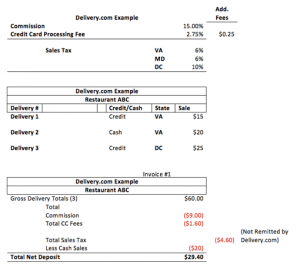
Lets Begin:
As the name implies, Delivery.com specializes in connecting customers with small businesses that are looking to go the extra mile by delivering goods directly to your door. Sounds convenient, if you’re the customer. For the business owner, they can expect to pay a commission of 15% and credit card fee of 2.75% plus $0.25 per card.
For the small business owner, or in this case, restaurant owner, this new concept can lead to confusion and stress if not understood properly. This guide should allow you to quickly understand Delivery.com from an accounting/bookkeeping perspective and (hopefully) allow you to make the decision on whether or not to give it a try.
Part One: The Explanation
First off, Delivery.com will not come to the store location to pick-up the goods as some other competing services do. Delivery.com (app and website) simply function as a platform for businesses (restaurants, grocers, liquor stores, and more) to deliver their own products to customers that want or need them at a commission fee of 15% (charged to the merchant of course). That being said, Delivery.com will handle credit card payments and charge the merchant (business owner) a 2.75% credit processing fee (standard) and an additional $0.25 per credit transaction (not so standard).
Delivery.com will also track your sales tax but will not remit it, meaning your deposits from delivery.com will not have sales tax deducted, the merchant is responsible for paying this. However, Delivery.com will report the amount owed on your invoice to simplify your life a bit more.
Here’s a breakdown of how the process would look to a business owner.
Part Two: The Invoice
As you can see, before sales tax this restaurant would gross $49.40 on $60 in food sales. If these sales were made in the restaurant they would gross $53.80 before sales tax. This can be a great way to expand business if the food margins have enough room for a 15% hit. If not, know that most restaurants are charging their customers a $5-$10 delivery fee through the Delivery.com platform, a good way to make up the difference on small orders, however since the fee is fixed it will not be as effective on larger orders.
Cash Flow Impact
It’s important to note the impact of delayed payments on the cash flows of the day-to-day operations. Delivery.com allows the merchant to choose between weekly direct deposit payments and monthly paper checks. If your restaurant is averaging $60 per day in delivery sales that’s $1,200 or so per month tied up in the float and unavailable to pay bills, payroll, etc.
A more realistic example is a restaurant open six nights a week averaging $3,200 per week in gross delivery sales (before any commission, fees, etc.) or $12,800 per month, that’s allot of money to have tied up in the float, especially if receiving monthly paper checks! In this example $12,800 would become about $10,000 after commission, credit card fees, and sales tax. Perhaps if the business is showing respectable and consistent delivery sales the owner could consider a line of credit against the average $10,000/month receivable if the interest payments aren’t an issue, solving the cash flow problem.
Okay, how do I make sense of this in the restaurants books? Well, here’s the same three sales from above entered into the delivery sales journal:
Part Three: The Accounting
Note that the sales tax is accounted for in this example however Delivery.com will not remit or deduct it from your invoice, it’s the owner’s responsibility to pay.
How do I add this service to my POS system? To QuickBooks?
As with all other delivery apps I suggest this be considered a method of payment in your POS system and QuickBooks, not a discount item (a common mistake).
Once you have added the item to your POS system, we recommend using QuickBooks POS Link to automatically post this, and all other daily entries from the POS System into QuickBooks – ensuring accuracy, saving time, and strengthening your bookkeeping by revenue center, time of day, and location.
Once delivery orders start flowing in the accounting can become more difficult, knowing that Dataurant’s “set it and forget it” software is transferring all the POS data to Quickbooks is one less task to worry about.
- Evan Henris is a Dataurant Pro and co-owner of Bacon n’ Ed’s A Nationally featured mobile gourmet kitchen.



